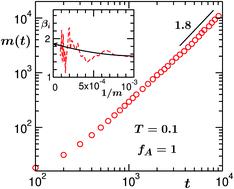当前位置:
X-MOL 学术
›
Soft Matter
›
论文详情
Our official English website, www.x-mol.net, welcomes your
feedback! (Note: you will need to create a separate account there.)
How do clusters in phase-separating active matter systems grow? A study for Vicsek activity in systems undergoing vapor–solid transition
Soft Matter ( IF 2.9 ) Pub Date : 2020-11-03 , DOI: 10.1039/d0sm01762k Subhajit Paul 1, 2, 3, 4, 5 , Arabinda Bera 1, 2, 3, 4, 6 , Subir K. Das 1, 2, 3, 4, 6
Soft Matter ( IF 2.9 ) Pub Date : 2020-11-03 , DOI: 10.1039/d0sm01762k Subhajit Paul 1, 2, 3, 4, 5 , Arabinda Bera 1, 2, 3, 4, 6 , Subir K. Das 1, 2, 3, 4, 6
Affiliation

|
Via molecular dynamics simulations, we have studied the kinetics of vapor–“solid” phase transition in an active matter model in which self-propulsion is introduced via the well-known Vicsek rule. The overall density of the particles is chosen in such a way that the evolution morphology consists of disconnected clusters that are defined as regions of high density of particles. Our focus has been on understanding the influence of the above-mentioned self-propulsion on structure and growth of these clusters by comparing the results with those for the passive limit of the model that also exhibits vapor–“solid” transition. While in the passive case growth occurs due to a standard diffusive mechanism, the Vicsek activity leads to very rapid growth, via a process that is practically equivalent to the ballistic aggregation mechanism. The emerging growth law in the latter case has been accurately estimated and explained by invoking information on velocity and structural aspects of the clusters into a relevant theory. Some of these results are also discussed with reference to a model for active Brownian particles.
中文翻译:

相分离活性物质系统中的簇如何增长?经历汽-固转变的系统中Vicsek活性的研究
通过分子动力学模拟,我们研究了活性物质模型中汽相-“固相”相变的动力学,在该模型中,通过众所周知的Vicsek规则引入了自我推进。以这样的方式选择颗粒的总密度,使得演化形态学由不连续的簇组成,簇被定义为颗粒的高密度区域。通过将结果与模型的被动极限(也显示出蒸汽-“固态”过渡)的结果进行比较,我们的重点一直在理解上述自推进对这些簇的结构和生长的影响。在被动情况下,由于标准扩散机制而发生了增长,而Vicsek的活动则通过实际上等同于弹道聚集机制的过程。通过将有关簇的速度和结构方面的信息纳入相关理论,可以准确地估计和解释后一种情况下出现的增长规律。还将参考活性布朗粒子模型来讨论其中一些结果。
更新日期:2020-11-19
中文翻译:

相分离活性物质系统中的簇如何增长?经历汽-固转变的系统中Vicsek活性的研究
通过分子动力学模拟,我们研究了活性物质模型中汽相-“固相”相变的动力学,在该模型中,通过众所周知的Vicsek规则引入了自我推进。以这样的方式选择颗粒的总密度,使得演化形态学由不连续的簇组成,簇被定义为颗粒的高密度区域。通过将结果与模型的被动极限(也显示出蒸汽-“固态”过渡)的结果进行比较,我们的重点一直在理解上述自推进对这些簇的结构和生长的影响。在被动情况下,由于标准扩散机制而发生了增长,而Vicsek的活动则通过实际上等同于弹道聚集机制的过程。通过将有关簇的速度和结构方面的信息纳入相关理论,可以准确地估计和解释后一种情况下出现的增长规律。还将参考活性布朗粒子模型来讨论其中一些结果。











































 京公网安备 11010802027423号
京公网安备 11010802027423号